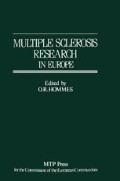Abstract
Many distinct lines of evidence suggest that immunopathological mechanisms are involved in onset und course of multiple sclerosis (MS). As examples, abnormally distributed immunoglobulins in the cerebrospinal fluid, shifts in T lymphocyte subset equilibria, and abnormalities in natural killer functions are commonly cited (McFarlin & McFarland, 1982; Waksman, 1983; Weiner & Hauser, 1982). Perhaps the most impressing argument in favor of an immunopathogenesis is, however, the morphological appearance of the MS lesion within the CNS white matter. Focal round cell infiltrations mainly around postcapillary venules, activation of astrocytes, and destruction of myelin are the key features. A practically identical lesion pattern is inducible by immunizing experimental animals with autologous white matter (Lassmann, 1983). The similarity between the inducible experimental autoimmune diesease and MS are so far the most compelling evidence for autoimmune mechanisms in the pathogenesis of MS.
Access this chapter
Tax calculation will be finalised at checkout
Purchases are for personal use only
Preview
Unable to display preview. Download preview PDF.
Literature
Ben-Nun, A., Eisenstein S., and Cohen, I.R. 1982. Experimental autoimmune encephalomyelitis (EAE) in genetically resistant rats: PVG rats resist active induction of EAE but are susceptible to and can generate EAE effector T cell lines. J. Immunol. 129: 918–919.
Ben-Nun, A., Wekerle, H., and Cohen, I.R. 1981. The rapid isolation of clonable, antigen-specific T lymphocyte lines capable of mediating autoimmune encephalomyelitis. Eur. J. Immunol. 13: 195–199.
Ben-Nun, A., Wekerle, H., and Cohen, I.R. 1981. The rapid isolation of clonable, antigen-specific T lymphocyte lines capable of mediating autoimmune encephalomyelitis. Eur. J. Immunol. 13: 195–199.
Fontana, A., Dubs, R., Merchant, R. Balsiger, S., and Grob, P.J. 1981. Glia cell stimulation factor (GSF): A new lymphokine. 1. Cellular sources and partial purification of murine GSF. role of cytoskeleton and protein synthesis in its production. J. Neuroimmunol., 2: 55–71.
Fontana, A., Kristensen, F., Dubs, R., Gemsa, D., and Weber, E. 1982. Production of prostaglandin E and an interleukin-1 like factor by astrocytes and C6 glioma cells. J. Immunol., 129: 2413–2419.
Gasser, D.L., Palm, J., and Gonatas, N. K. 1975. Genetic control of susceptiblity to experimental allergic encephalomyelitis and the AgB locus of rats. J. Immunol. 115: 431–433.
Günther, E., Odenthal, H., and Wechsler, W. 1978. Association between susceptibility to experimental allergic encephalomyelitis and the major histocompatibility system in congenic rat strains. Clin. Exp. Immunol. 32: 429–434.
Hirsch, M.-A., Wietzerbin, J., Pierres, M., and Goridis, C. 1983. Expression of la antigens by cultured astrocytes treated with gamma-interferon. Neurosci. Lett., 41: 199–204.
Hirschberg, H., Bergh, O.J., and Thorsby, E. 1980. Antigen-presenting properties of human vascular endothelial cells. J. Exp. Med., 152: 249–255.
Hirschberg, H., Bergh, O.J., and Thorsby, E. 1980. Antigen-presenting properties of human vascular endothelial cells. J. Exp. Med., 152: 249–255.
Kimelberg, H.K. 1983. Primary astrocyte cultures — a key to astrocyte function. Cell.Mol.Neurobiol. 3: 1–16.
Lassmann, H. 1983. Comparative neuropathology of chronic experimental allergic encephalomyelitis and multiple sclerosis. Springer Verl., Berlin
Linington, C., Izumo, S., Suzuki, M., Uyemura, K., Meyermann, R., and Wekerle, H. 1984. A permanent rat T cell line that mediates Experimental Allergic Neuritis in the Lewis rat in vivo. J. Immunol. 133: 1946–1950.
McFarlin, D.E., and McFarland, H.F. 1982. Multiple Sclerosis. N.E.J.M., 307: 1183–1188; 1246–1251.
Naparstek, Y., Ben-Nun, A., Holoshitz, J., Reshef, T., Frenkel, A., Rosenberg, M. and Cohen I.R. 1983. T lymphocyte lines producing or vaccinating against autoimmune encephalomyelitis (EAE). Functional aactivation induces peanut agglutinin receptors and accumulation in the rain and thymus of line cells. Eur. J. Immunol. 13: 418–423.
Naparstek, Y., Cohen, I. R., Fuks, Z., and Vlodavsky, I. 1984. Activated I lymphocytes produce a matrix-degrading heparan sulphate endoglycosidase. Nature, 310: 241–244.
Osawa, H., and Diamantstein, T. 1983. The characteristics of a monoclonal antibody that binds specifically to rat T lymphoblasts and inhibits IL-2 receptor functions. J. Immunol., 130: 51–55.
Poper, J.S., Gimbrone, M.A., Cotran, R.S., Reiss, C.S., Bukaroff, S.J., Fierz, W., and Ault, K.A. 1983. Ia expression by vascular endothelium is inducible by activated T cells and by human y-interferon. J. Exp. Med. 157: 1339–1353.
Savion, N., Vlodavsky, I., and Fuks, Z. 1984. Interaction of T lymphocytes and macrophages with cultured vascular endothelial cells: Attachment, invasion and subsequent degradation of the subendothelial extracellular matrix. J.Cell.Physiol. 118: 169–178.
Sun, D., and Wekerle, H. 1985. Antigen-specific, la-restricted lysis of rat brain astrocytes by syngeneic encephalitogenic T lymphocyte line cells. Epitope dependency of killing function? Submitted.
Vass, K., Lassmann, H., Wekerle, H., and Wisniewski, H.M. 1985. The distribution of la-antigen in the lesions of rat acute experimental allergic encephalomyelitis. Submitted.
Waksman, B.H. 1983. Immunity and the nervous system: Basic Tenets. Ann. Neurol., 13: 587–591.
Weiner, H.L., and Hauser, S.L. 1982. Neuroimmunology I: Immunoregulation in neurological disease.Ann. Neurol., 11: 437–449.
Wekerle, H. 1984. The lesion of acute Experimental autoimmune encephalomyelitis. Lab.Invest., 51: 199–205.
Wekerle, H., and Schlusener, H.J. 1985. Autoaggressive T lymphocyte lines recognizing the encephalitogenic region of myelin basic protein: in vitro selection from unprimed rat T lymphocyte populations. Submitted.
Wong, G.H.M., Bartlett, P.F., Clark-Lewis, I., Battye, F., and Schrader, J.W. 1984. Inducible expression of H-2 and la antigens on brain cells. Nature, 310: 688–691.
Editor information
Editors and Affiliations
Rights and permissions
Copyright information
© 1986 ECSC, EEC, EAEC, Brussels and Luxembourg
About this chapter
Cite this chapter
Wekerle, H. (1986). Molecular and Cellular Basis of Autoimmune Encephalitogenesis. In: Hommes, O.R. (eds) Multiple Sclerosis Research in Europe. Springer, Dordrecht. https://doi.org/10.1007/978-94-009-4143-4_26
Download citation
DOI: https://doi.org/10.1007/978-94-009-4143-4_26
Publisher Name: Springer, Dordrecht
Print ISBN: 978-94-010-8338-6
Online ISBN: 978-94-009-4143-4
eBook Packages: Springer Book Archive

